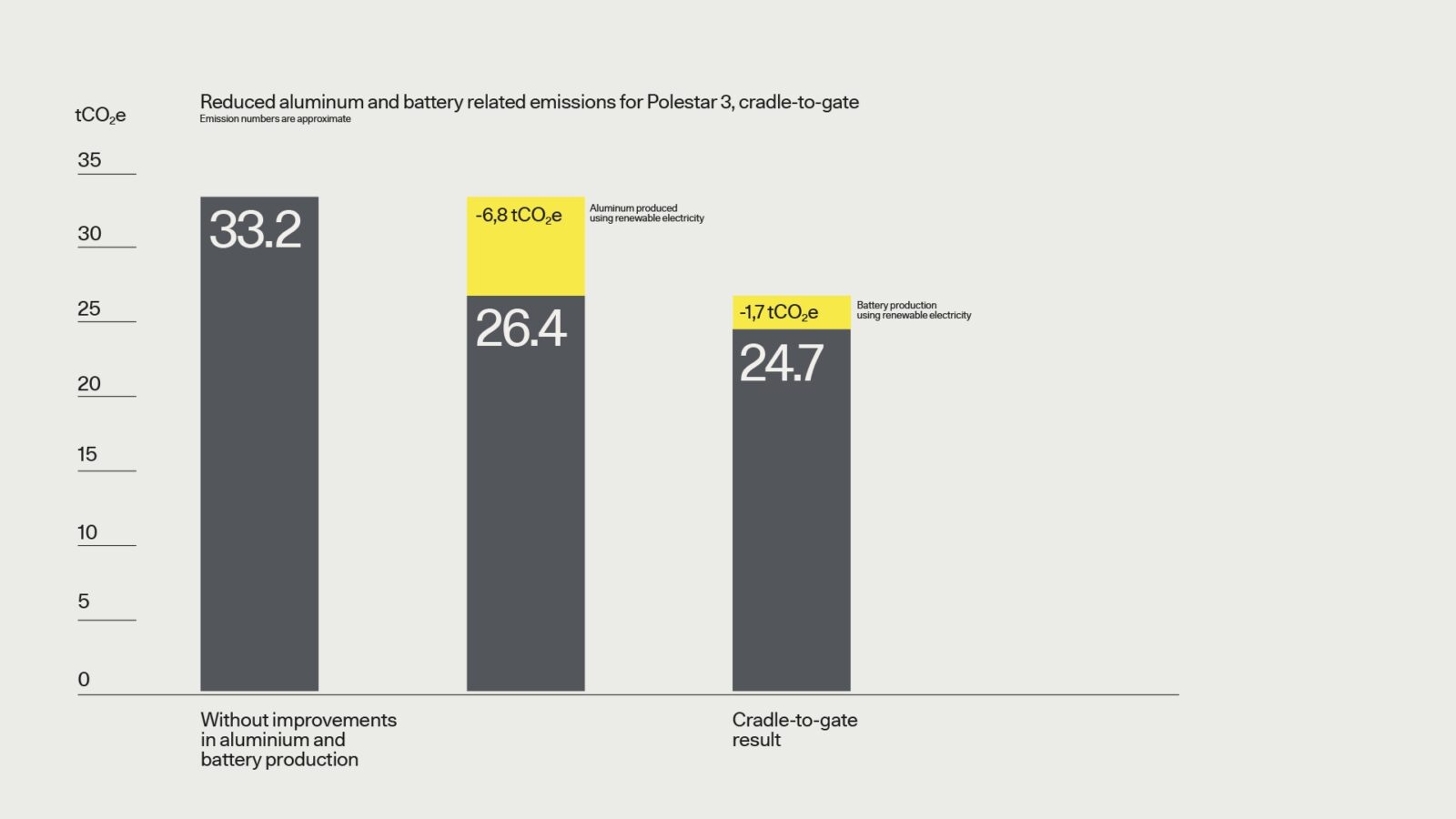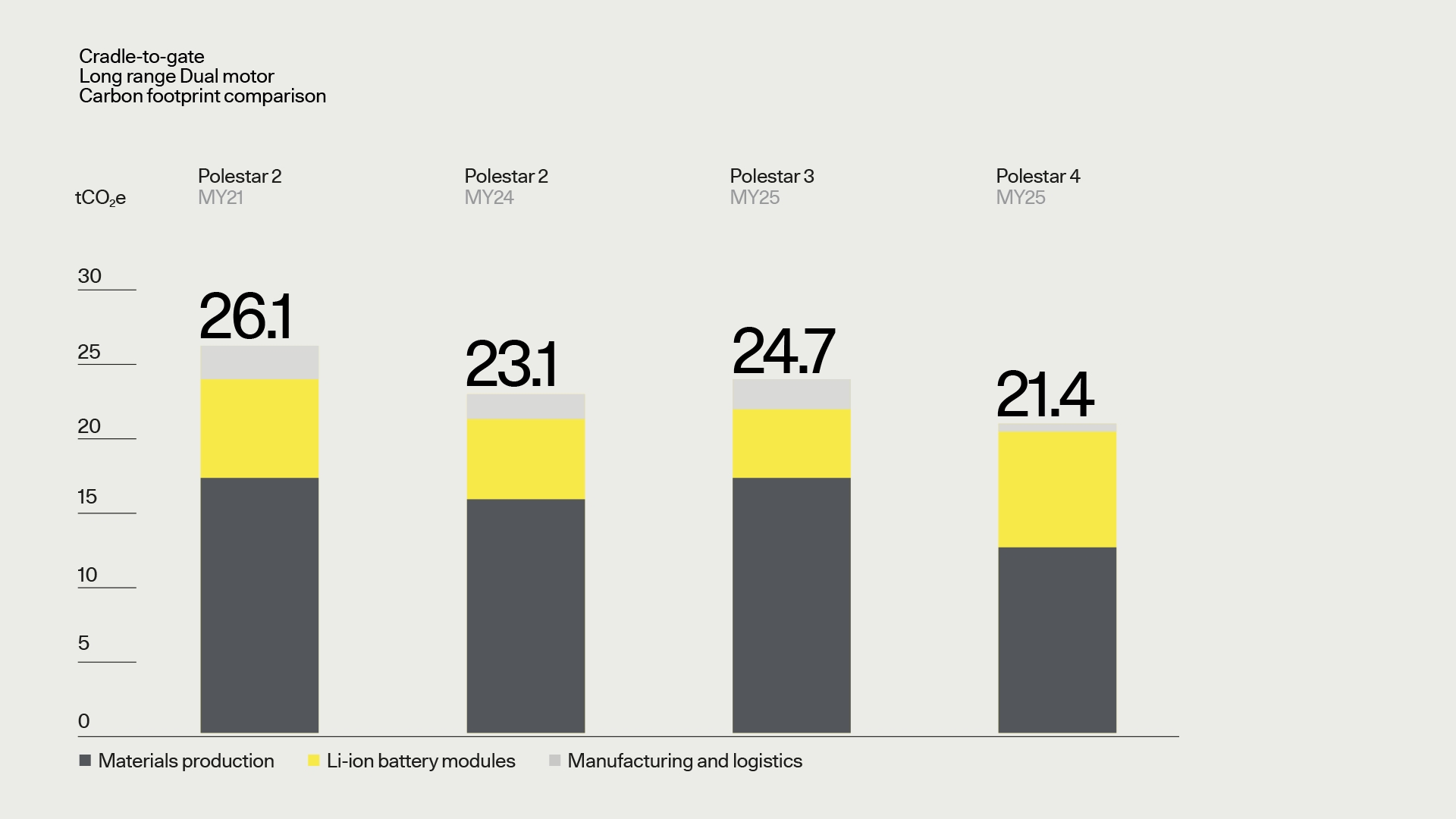Sign up for daily news updates from CleanTechnica on email. Or follow us on Google News!
Polestar 3 Cuts Its Carbon Footprint To 24.7 tCO2e By Reducing Aluminium & Battery Related Emissions
Polestar creates exclusive electric performance cars that harness minimalistic design, technological innovations, and sustainable solutions to make the desirable choice and the right choice one and the same. As a result, the total cradle-to-gate carbon footprint of Polestar’s first electric performance SUV, Polestar 3, is lower than that of the smaller Polestar 2 when it was launched in 2020 at 24.7 tCO2e versus 26.1 tCO2e. Proof that even for large SUVs action can be taken to reduce their climate impact.
The majority of greenhouse gas (GHG) emissions stem from the extraction and processing of various materials, with three components — aluminium, steel, and batteries. The Lifecycle Assessment (LCA) report for Polestar 3 shows that material production and refining contribute 68% of its cradle-to-gate carbon footprint of which aluminium represents 24%, iron and steel 17% and battery module production 24%.
Our work at Polestar aims to implement existing solutions, advocate for emerging solutions, and actively address what is currently considered unsolvable. Existing solutions may involve purchasing aluminum produced using renewable electricity, emerging solutions could include steel made with renewable energy, and entirely new solutions may relate to electronics, tires, and thermoplastics.
The approach to meeting the ambitious cradle-to-gate target for Polestar 3 took learnings from the carbon footprint reductions of Polestar 2. Consequently, 81% of Polestar 3’s total aluminium mass production, the Li-ion battery cell module production as well as anode and cathode material production use 100% renewable electricity. By doing this, 8.5 tCO2e have been eliminated.
Manufactured initially at Volvo Cars’ Chengdu factory in China, additional production is slated to start in South Carolina, USA, in the middle of 2024. Both manufacturing plants use 100% renewable electricity. A separate LCA will be produced for cars produced in this factory.
Fredrika Klarén, Head of Sustainability at Polestar, says: “The majority of a vehicle’s greenhouse gas emissions stem from extracting and processing materials. As we accelerate the adoption of electric cars, there is a lot we can do to reduce their production-related emissions and strengthen the role of innovations and of electric cars as a climate solution, Polestar 3 is a testament to that.”
Comprehensive transparency about the environmental impact of the car is offered by the LCA report. The LCA has been calculated using three different electricity mixes and a 200,000 km lifetime distance driven. The methodology to assess the electricity in use phase has been updated and now includes more realistic scenarios from the IEA (International Energy Agency) which take into account increased shares of renewables, underscoring their potential for reducing the car’s emissions during the use phase. For the first time in any Polestar LCA, vehicle maintenance is included in the calculations. The car’s cradle-to-grave carbon footprint ranges between 28.5 – 44.5 tCO2e depending on the electricity used to charge the vehicle during its lifetime.
The LCA report, conducted in accordance with ISO 14067:2018, is the first Polestar LCA report that has been reviewed by a third party, the global strategic, environmental, and engineering consultancy Ricardo plc.
The Polestar 3 LCA report can be found on polestar.com/sustainability/reports/.
The Polestar 3 Product Sustainability Declaration can be accessed at polestar.com/polestar-3/sustainability/
Notes to editors
Polestar 3 joins the Polestar portfolio alongside Polestar 4, which was confirmed in late 2023 to have the lowest cradle-to-gate carbon footprint of any Polestar car at launch (19.4-21.4 tCO2e). Since launch in 2020, the cradle-to-gate carbon footprint of Polestar 2 has been reduced by three tonnes in three years (now 22.4-23.1 tCO2e).
Polestar’s LCAs, published since 2020, consider a range of factors in a car’s life cycle, from supply to manufacture and recycling, and summarise the climate impact in one easily understood number. This enables consumers to make quick and educated decisions when buying a car. The LCA figures stated in this release disclose the cars’ cradle-to-gate carbon footprint which includes material acquisition through the production of the product and excludes the use and end-of-life stages. The LCA figures related to the vehicles’ cradle-to-grave carbon footprint present a total carbon footprint of the car adding use phase and end-of-life on top of its cradle-to-gate carbon footprint.
Have a tip for CleanTechnica? Want to advertise? Want to suggest a guest for our CleanTech Talk podcast? Contact us here.
Latest CleanTechnica TV Video
CleanTechnica uses affiliate links. See our policy here.







